The day was beautiful with sun out bright and temps just perfect. The Trail head starts at either Heron Lake or at El Vado Lake. It runs through the Chama wildlife management area and it’s 5.5 miles-one way. However, due to the fact that the trail does go through the wildlife management-we could only walk a ways before we had to turn around. The wildlife management is closed until Memorial weekend, when it all opens up to hikers.
So being that we are camped at Heron Lake, we started at that end. When first driving towards the trail head, you see what we would call a graveyard for junk. It belongs to the state park and it’s where they either store or keep their extra docks; whether in good shape or not. Also is a huge pile of large boulders that they use as blockage to areas they don’t want folks near.
But once parked, is a very nice area with a few picnic table and a couple of benches overlooking the trail head and the canyon. Plenty of shade with large Ponderosas around.
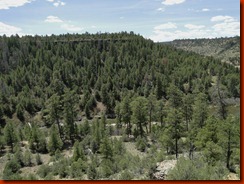 '
'When first starting out at this end (Heron Lake), you will descend down a wooden staircase before you start with switchbacks until you get down to the river and the swinging bridge.
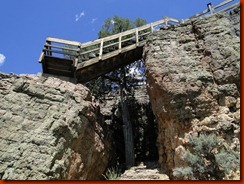

If hiking in springtime, be warn-you may get buzzed by hummingbirds; Specially if you wear red hat!
As you approach the river you come to an extension bridge, or as some call a swinging bridge that goes across the Rio Chama. This was built by the Youth Conservation back in the 80’s. since then the State Park has tried to maintain this trail through federal grants. The staircase and the bridge is solid, but the switchback shows signs of washout and abuse. The repairs are done the best way it could be done. However, this trail is not for those with bad knees, hips or are frail.
Many only go as far as the bridge, and then turn around, instead of taking the hike further on, as we did. The bridge is really amazing as how it’s being supported.
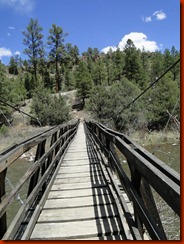
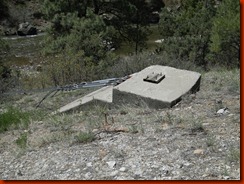
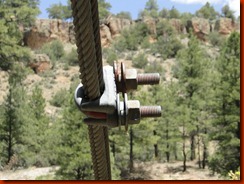
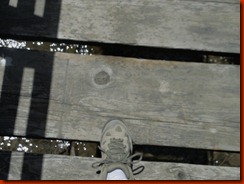
In the above pictures, the first one shows the cables that support this bridge. The second picture shows one of four cements that supports the cables. Third picture shows the size of u-bolts that are used. And the fourth picture shows how far apart the boards maybe in crossing. Word of caution: if small children are with you-you might want to watch them closely-so not to get their foot caught!
And yes, you can make the bridge swing-we did!
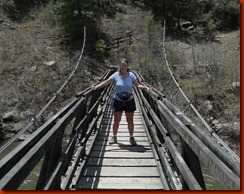 I was hanging on while Brian was both trying to take my picture and swing the bridge.
I was hanging on while Brian was both trying to take my picture and swing the bridge.Now that you are done playing on the bridge, it’s time to take the hike. At first we thought that we would climb back straight up the ridgeline-but instead we veered to the right and went along the edge-keeping the Rio Chama in eyesight the whole time. Then we curved and slowly started the climb upwards. We just went slow and steady and enjoyed the view.
You are socked in with Ponderosa, Juniper and other types of trees. Being it was morning, it was cool during this part of the hike, and breathtaking.
What seemed like we should have gone at least 3/4th of mile or better, we only went about 1/4th of a mile. This was due to the climb upwards and going slow. We came across a picnic table out in the middle of nowhere, with somewhat a view through the tree lines of the Heron Dam.
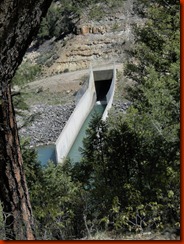
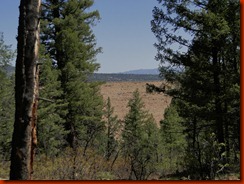
As we continue on the hike, we came across an interesting spot where a large boulder had sometime recently broken off, coming down the mountain side and crossing over the trail before landing in it’s new permanent spot. To one’s eye that didn’t know better, they would have assumed that this happened in the last few years. But upon reading and researching it was learned that it happened back in 2005. Here is a picture of the slide, and where the rock landed:
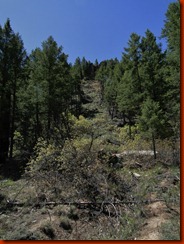
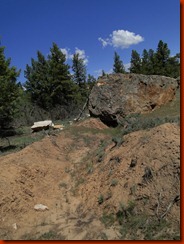
There were points of the trail that was overgrown and narrow and at times we even wonder if we were actually on the trail. The only marker you have is after each mile, if you look closely you may come across a mile marker. The terrain was uneven crossing from rocks, to solid mud to needle pack or leave pack ground; and you really never knew what was or might be around the bend. We always kept our eyes wide open and our ears tune to our surrounding at all times.
We finally came to a place where there was a marker that explained the area and that the overview from there was now overlooking El Vado Lake. This was a good resting area for refueling our bodies with nutrition.
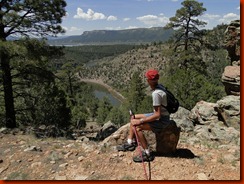
Farther down the trail we came across a spectacular view of both El Vado Lake and Heron Lake.
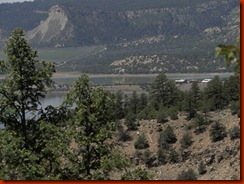 El Vado Lake with the pennisula…You can’t see it well in this picture, but the middle house apparently was recently destroyed by a fire. Can you image the view these people have?
El Vado Lake with the pennisula…You can’t see it well in this picture, but the middle house apparently was recently destroyed by a fire. Can you image the view these people have?We kept on this hike, we knew that we could not do the whole hike this day and would only travel half of it. Every time we thought we might turn around, our curiosity would get the best of us and we would say “let’s go to the next bend”. We still had plenty of water and we know that when half gone, we would have no choice BUT to turn around-for our own safety.
Anyways once again we said we would go to the crevasse in the rocks-but again we decided to climb through this crevasse and reach the top mesa before turning around. It was very narrow and due to the weather warming, we had to go cautiously for unwelcome critters (snakes). I only got half way up when I was greeted with 100’s of flies. I told Brian to turn around and head back down. Not sure what had caused all those flies, but we didn’t want to stick around and see either. It was time to head back. (We soon later learned that at this mesa-the trail closes and becomes part of the wildlife management).
Heading back, a little slower, we came across some scat. It belonged to a bear. What discover that it apparently crosses here frequently because there was “old” scat with fresh on top. As we were “examining” this scat, we heard noises below us and then a cub bear crying for momma; It defiantly was time to get out of there!
Whew-that was a little too close. We both had our mace ready, whistles/horns in hand and we kept looking back over our shoulder just to make sure we were not being followed.
All-in-all we had a great hike and loved every minute of it. We calculated on our GPS (E-Trex) that we hiked just about 5 miles round trip and took us 4 hours. We had to take lots of camera breaks and of course water and food break.
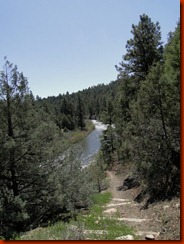

Some day we may return when the whole trail system is open and due the whole thing-round trip.
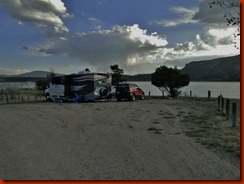
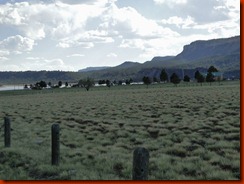
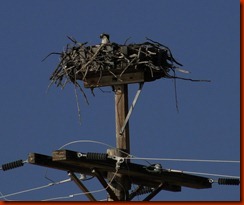
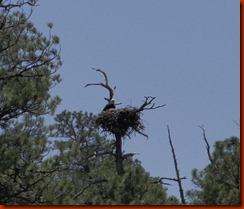
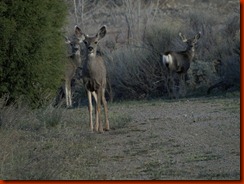
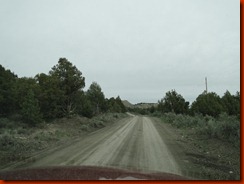
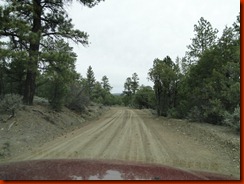

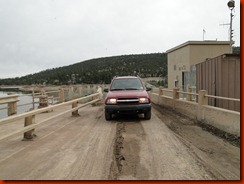
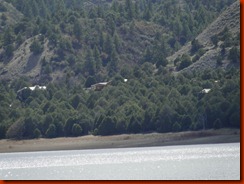 Homes that are tucked in along Lakeshore Drive.
Homes that are tucked in along Lakeshore Drive.